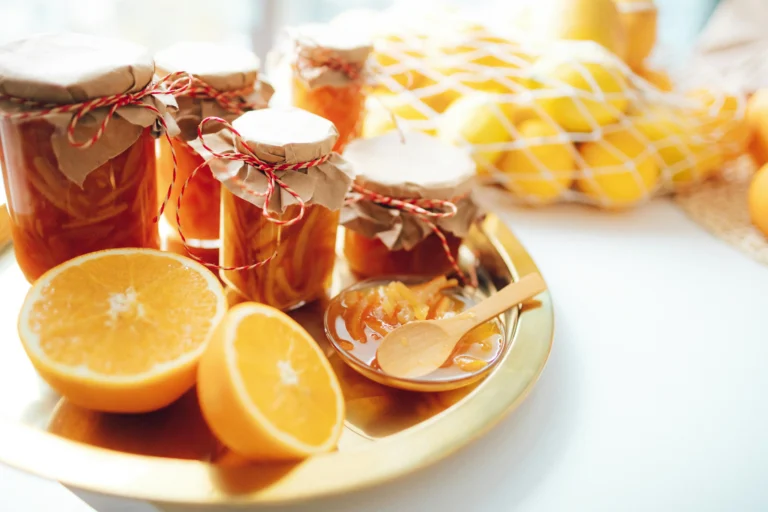You + a jar of sunshine (heart-led opening)
Imagine your kitchen on a slow morning: kettle whispering, toast still warm, and a jar of glowing citrus you made yourself. When you spread marmalade, you’re not just sweetening breakfast—you’re bottling zest, thrift, and a small ritual you can return to all week. This step-by-step orange marmalade recipe shows you how to get a clean set, a balanced bite (bright, not harsh), and safely sealed jars—without overspending.
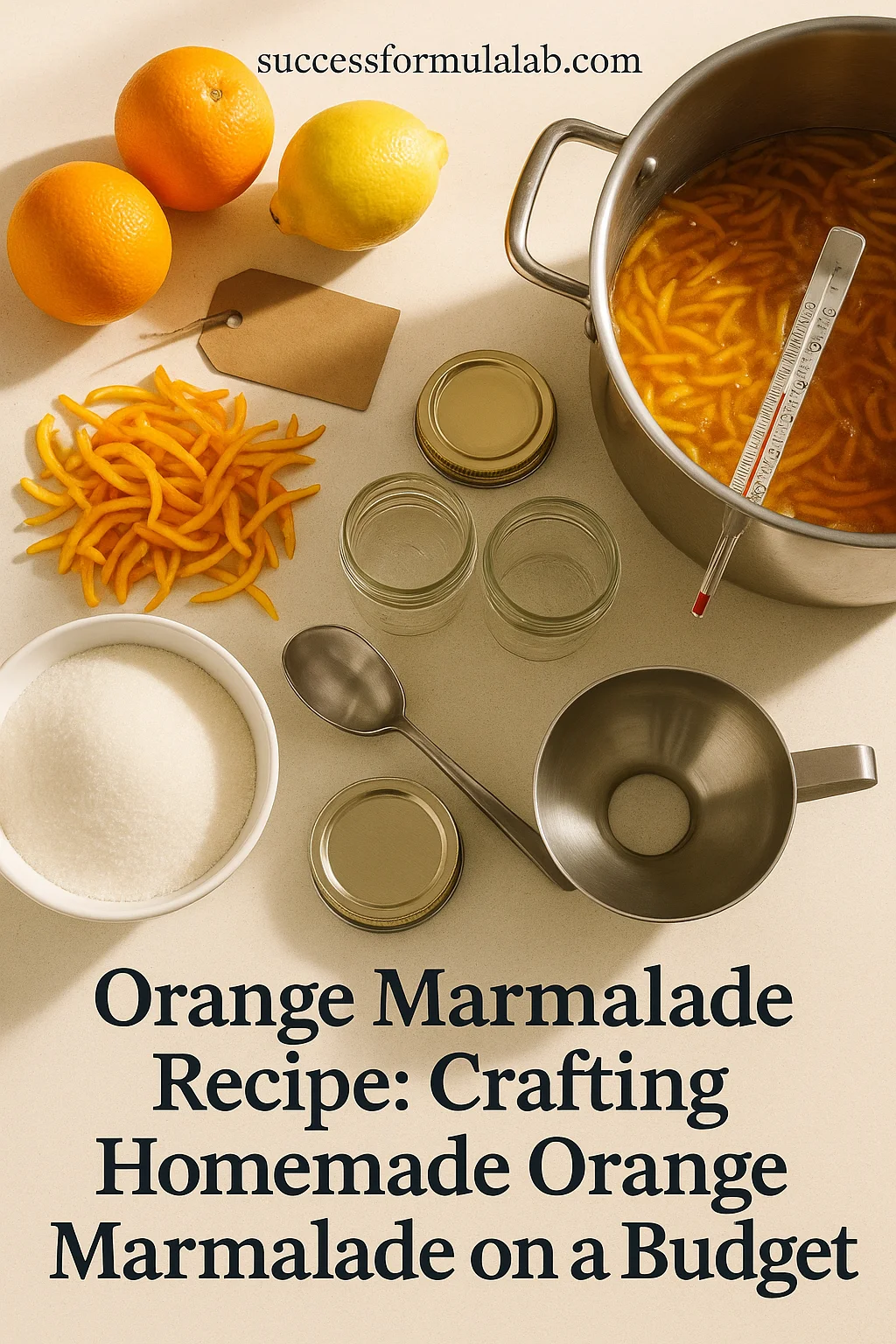
What makes great marmalade (flavor, pectin, acidity)
-
Flavor balance: Marmalade lives where bitter peel, sweet sugar, and sparkling acidity meet. You’ll temper bitterness by slicing the peel very thin and simmering until tender before sugar goes in.
-
Natural pectin: Citrus peel, seeds, and membranes carry plenty of pectin. A simple pectin bag (seeds + membranes tied in cheesecloth) boosts gel strength—no boxed pectin required.
-
Setting point: Aim for 104 °C / 220 °F at sea level or use the chilled-plate wrinkle test.
-
Safety: Citrus is naturally high-acid. With proper headspace and a boiling-water canner, marmalade is a straightforward preserve to process at home.
Budget breakdown: pennies per jar
Seasonal oranges + pantry sugar = the most cost-effective preserve you can make. You’re using the whole fruit (peel + juice), so very little is wasted.
Sample cost table (fill with your local prices)
| Item | Qty for ~8–9 half-pint (240 ml) jars | Unit price | Line total |
|---|---|---|---|
| Oranges (Seville or navel mix) | 2.5 kg / 5.5 lb | — | — |
| Lemons | 2 large | — | — |
| Granulated sugar | 2.0–2.2 kg / 10–11 cups | — | — |
| Water | 2–2.5 L / 8–10 cups | — | — |
| New canning lids | 9 | — | — |
| Estimated cost per jar | 240 ml | — |
Money-saving tips
-
Buy oranges by the case in peak season; split with a friend.
-
Reuse clean jars you already own; always use new lids.
-
Pre-warm sugar in a low oven to shorten the final boil (saves energy and reduces crystallization risk).
Pantry win: To make your citrus work harder all year, this practical guide to long-keeping superfoods and proven preservation methods shows exactly what to stock beside your marmalade—so your shelves stay useful, not just pretty.
Choose your oranges (bitterness vs. brightness)
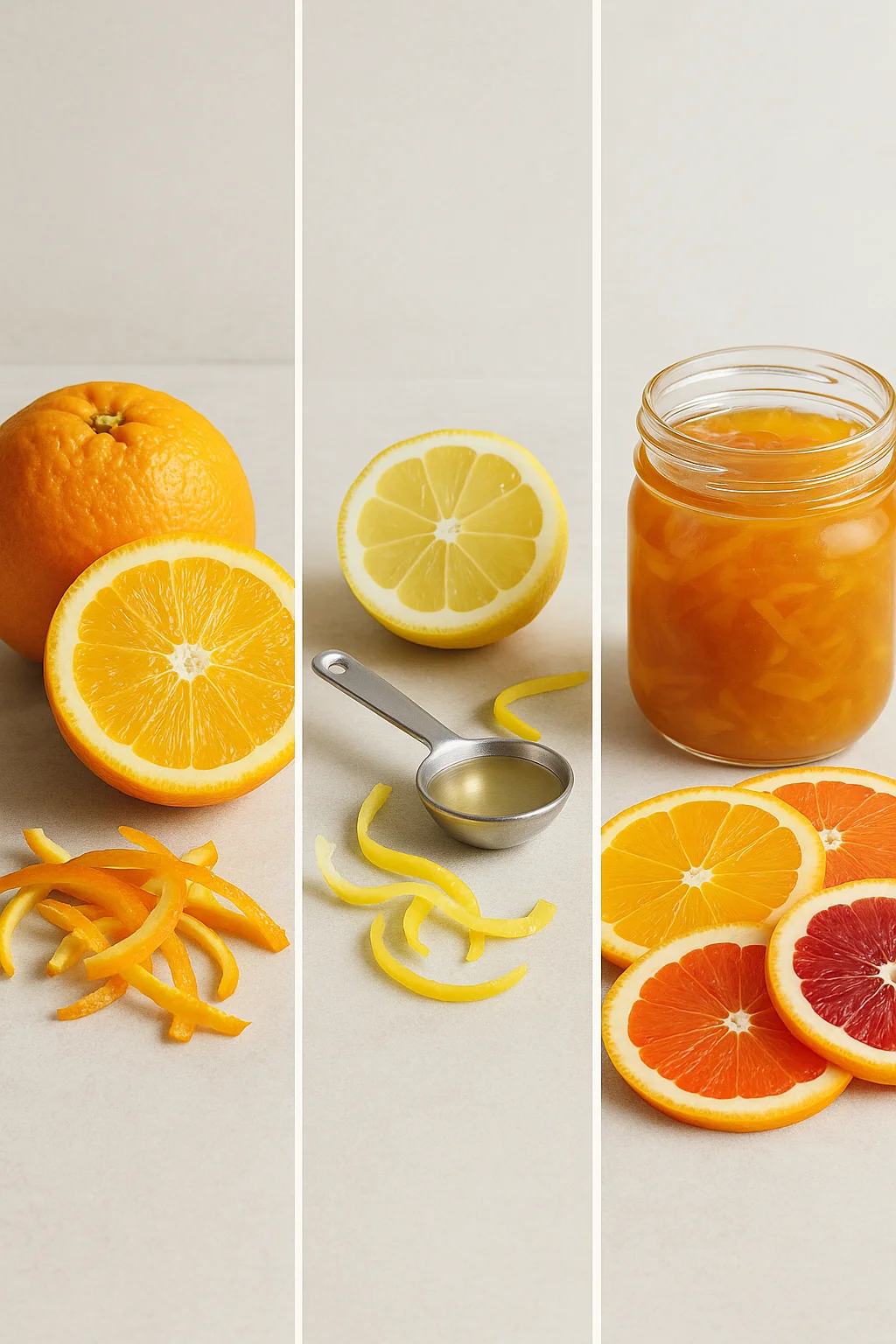
Best varieties
-
Seville oranges: Classic marmalade bite, lush oils, high natural pectin.
-
Navel / Cara Cara / Blood orange: Sweeter and less bitter; add a touch more lemon juice to help the set.
-
Mixing fruit: A Seville + navel blend often gives rounded flavor and a reliable gel.
Prep like a pro
-
Wash & de-wax: Rinse fruit in hot water and scrub well.
-
Halve & juice: Strain juice; reserve seeds and membranes (pectin gold).
-
Slice peel thin: Aim for matchstick-thin strips; thin peel tastes refined and sets more evenly.
-
Make a pectin bag: Tie seeds/membranes in cheesecloth with kitchen twine.
Tools you’ll use (nothing fancy)
-
Wide, non-reactive pot (evaporates fast = better set)
-
Sharp knife and cutting board
-
Kitchen scale (helpful) or measuring cups
-
Instant-read or candy thermometer (optional but nice)
-
Cheesecloth + twine (for the pectin bag)
-
Canning jars with new lids + rings
-
Jar lifter, funnel, clean towels, and a boiling-water canner (or deep stockpot with rack)
Core Orange Marmalade Recipe (no added pectin)
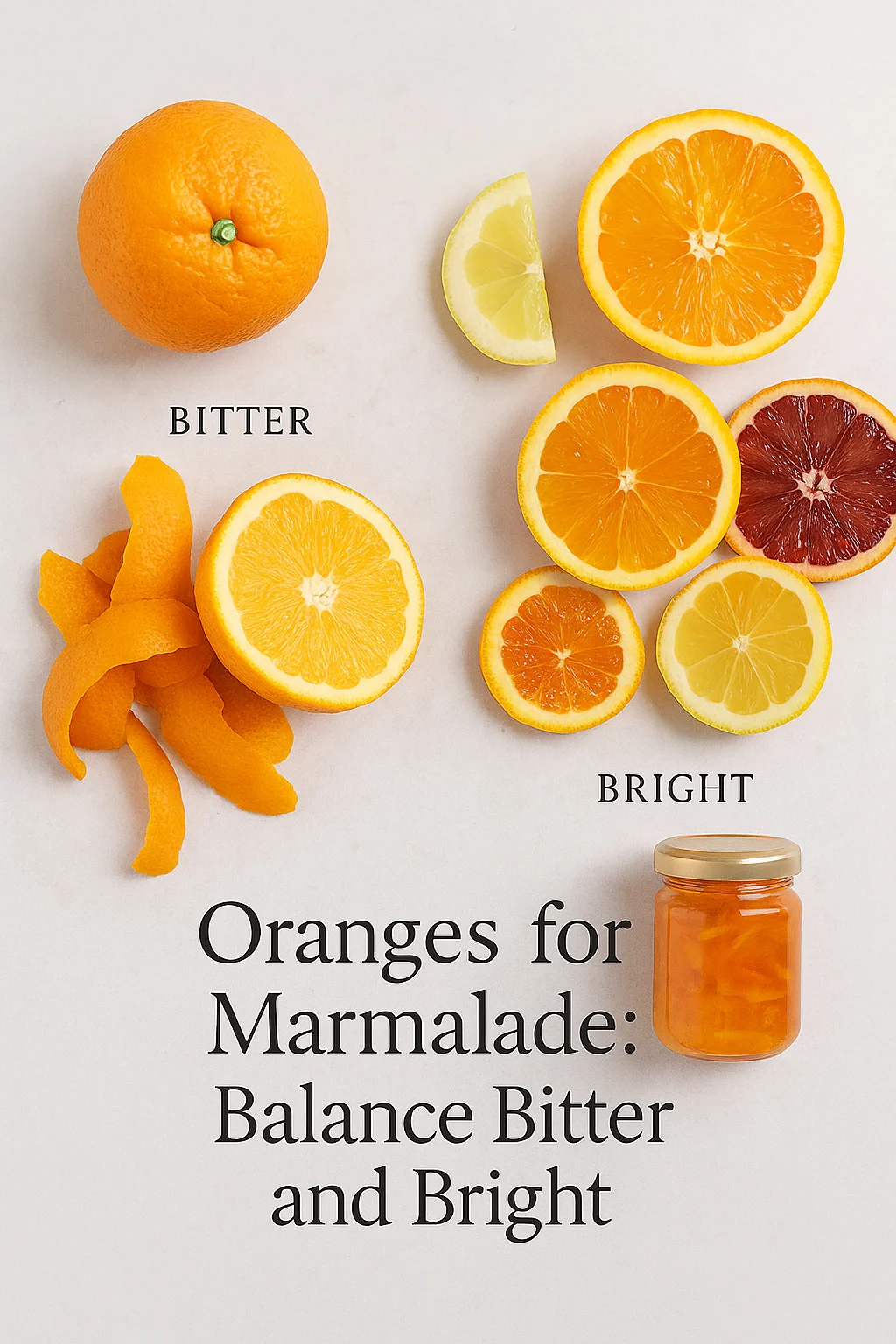
Ingredients (metric + US)
| Ingredient | Metric | US measure | Notes |
|---|---|---|---|
| Oranges (Seville preferred; or a mix) | 2.5 kg | ~12–14 medium | Thinly sliced peel + all juice |
| Lemons (juice) | 2 large | 2 | Brightens flavor, aids set |
| Water | 2–2.5 L | 8–10 cups | Enough to just cover peel |
| Granulated sugar | 2.0–2.2 kg | 10–11 cups | Start 1:1 with cooked fruit mass |
Yield: ~8–9 × 240 ml jars (varies with evaporation)
Method (step-by-step)
-
Macerate (optional but excellent): In a non-reactive pot, combine sliced peel, collected juices, and enough water to just cover. Refrigerate 8–12 hours. Maceration softens peel and deepens citrus oils.
-
Simmer the peel: Add your pectin bag. Bring to a gentle simmer and cook 45–60 minutes until peel is tender when pinched.
-
Measure fruit mass: Remove the pectin bag (squeeze it over the pot with tongs—cloudy pectin-rich juice will drip back). Weigh or measure the hot fruit mixture.
-
Add warmed sugar: Pre-warm sugar in a 95 °C / 200 °F oven for 10–15 minutes. Stir sugar into the hot pot until completely dissolved (no graininess on the spoon).
-
Boil hard to set: Crank the heat and boil vigorously, stirring often and skimming foam. Watch for one (or more) of these signals:
-
Thermometer: 104 °C / 220 °F (sea level).
-
Wrinkle test: Drop a spoon of marmalade on a chilled plate, wait 30 seconds, then push with a finger—wrinkles mean “set.”
-
Sheet test: Marmalade falls in a sheet off the spoon, not in drips.
-
-
Jar & process: Ladle hot marmalade into hot jars, leaving ¼-inch (6 mm) headspace. Bubble-pop with a tool, wipe rims, add lids and rings finger-tight.
-
Water-bath can: Process 10 minutes at 0–1000 ft altitude (see adjustments below). Turn off heat, rest 5 minutes, then lift jars to a towel. Do not tilt.
-
Cool & store: After 12–24 hours, check seals (lids concave, no flex), remove bands, wipe jars, label, and store cool and dark.
Altitude adjustments (rule-of-thumb)
| Altitude | Add to 10-min process |
|---|---|
| 1001–3000 ft (305–914 m) | +5 min (total 15) |
| 3001–6000 ft (915–1829 m) | +10 min (total 20) |
| 6001–8000 ft (1830–2438 m) | +15 min (total 25) |
Always follow up-to-date home-canning guidance for your region and jar size.
Texture & set control (never runny, never rubbery)
-
Too soft after cooling? Re-boil with 1–2 tbsp lemon juice and a small portion of the peel liquor (if saved) for a few minutes, then re-jar and re-process.
-
Too firm? Warm a jar gently and stir in a splash of hot water to loosen for serving. Next time, stop the boil a minute earlier.
-
Crystals on the sides? That’s sugar crystallization. Prevent it by fully dissolving sugar before the hard boil and not scraping pot sides when jarring.
-
Foam on top? Skim during the boil or stir in a ½ tsp butter once off heat (skip if you’re strictly dairy-free).
Variations (dial sugar, spice, or citrus mix)
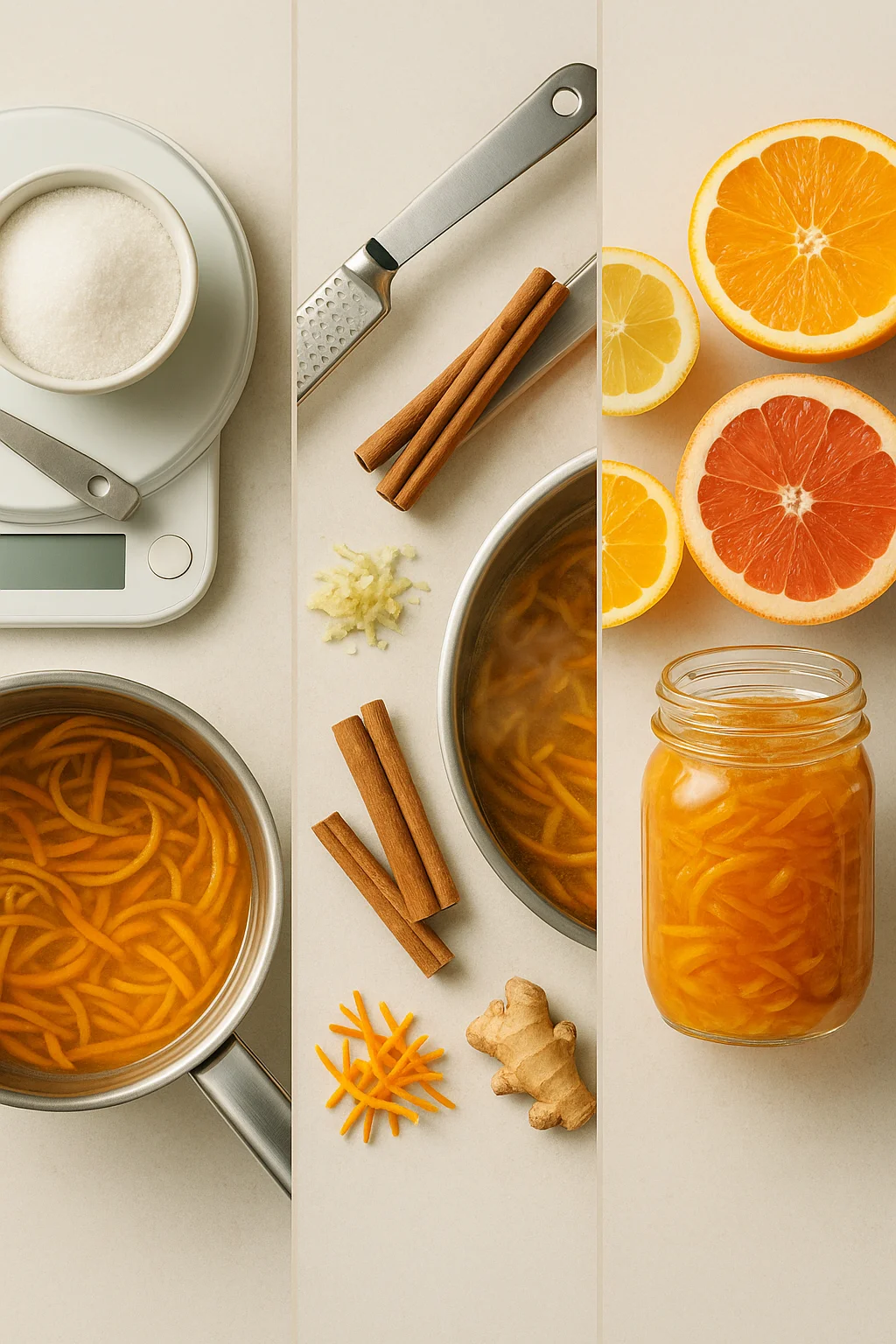
Low-Sugar Orange Marmalade Recipe (LM pectin)
-
Use low-methoxyl (LM) pectin with calcium water as directed by the manufacturer.
-
Sweeten to taste (sugar or honey) after gel begins—LM pectin sets with calcium, not sugar.
-
Expect a softer, fruit-forward set.
Ginger-Spiced Marmalade
-
Add 1–2 tbsp finely grated fresh ginger during the final boil.
-
Optional: a pinch of cinnamon or cardamom for warmth.
Whisky Orange Marmalade
-
Off heat, stir in 2–4 tbsp whisky for aroma (a top note, not a boozy spread).
-
Jar and process as usual.
Three-Citrus Marmalade (orange + lemon + grapefruit)
-
Balance grapefruit’s bitterness with extra lemon and, if needed, a little more sugar.
Safe canning & storage (preservation basics)
-
Process time: Typically 10 minutes at sea level; adjust for altitude.
-
Headspace: ¼-inch (6 mm) for a strong vacuum.
-
Cooling: Let jars rest, undisturbed, 12–24 hours.
-
Check seals: Lids concave and firmly sealed; remove bands for storage (prevents rust and false seals).
-
Shelf life: Cool, dark storage up to 12–18 months for best quality; refrigerate after opening and use within 3–4 weeks.
-
Discard if: Unsealed lid, visible mold, spurting, or off odors.
Stock a Pantry That Loves Marmalade
Pair your jars with smart, shelf-stable staples and preservation tips that actually hold up.
Serving ideas (beyond toast)
-
Breakfast wins: Stir into oatmeal, layer with yogurt and granola, or glaze warm scones.
-
Savory magic: Thin with a splash of water or soy + chili and brush over salmon, chicken, roasted carrots, or halloumi.
-
Cheeseboard: A spoon of marmalade with aged cheddar or goat cheese is instant elegance.
-
Baking: Thumbprint cookies, layer cakes, crêpes, Danish, or a citrus swirl in brownies.
Troubleshooting quick-look table
| Problem | Likely cause | Fast fix |
|---|---|---|
| Too bitter | Thick pith; peel not tender before sugar | Slice thinner; simmer peel longer pre-sugar |
| Won’t set | Not enough boil; low acid | Re-boil to 220 °F / 104 °C; add 1–2 tbsp lemon juice |
| Grainy or crystals | Sugar not fully dissolved | Warm sugar; dissolve fully before hard boil; don’t scrape pot sides |
| Cloudy jars | Foam/debris carried in | Skim foam; ladle from center; wipe rims well |
| Dark color | Over-boil / slow evaporation | Use a wide pot; boil hard but watch closely |
FAQs about the orange marmalade recipe
What oranges are best for an orange marmalade recipe?
For classic bite and perfume, choose Seville oranges. For a gentler profile, use navel, Cara Cara, or a mix—and add a little extra lemon juice to support the set.
How do you know your orange marmalade recipe has set?
Use any of these:
-
Thermometer: 104 °C / 220 °F at sea level
-
Chilled-plate wrinkle test
-
Spoon sheet test (marmalade falls in a sheet, not drops)
Can you make a low-sugar orange marmalade recipe?
Yes. Use low-methoxyl pectin with calcium. It gels without relying on large amounts of sugar, producing a bright, fruit-first flavor.
Do you need to sterilize jars first?
If you process for 10 minutes or longer in a boiling-water canner, you don’t need to pre-sterilize. Wash jars hot, keep them warm, then fill and process.
How long does homemade marmalade last?
Properly processed and stored in a cool, dark place, expect 12–18 months of top quality. Once opened, refrigerate and enjoy within 3–4 weeks.
Why did my marmalade turn too dark?
Likely an over-long boil in a narrow pot. Next time, use a wide pot (more surface area = faster evaporation) and boil hard—but monitor closely.
Printable recipe card (copy/paste)
Classic Orange Marmalade (No Added Pectin)
Yield: ~8–9 × 240 ml jars
Active time: 45–60 min simmer + 15–25 min hard boil (plus optional 8–12 h maceration)
Ingredients
-
Oranges, thinly sliced (peel + juice) … 2.5 kg (5.5 lb)
-
Lemons, juiced … 2
-
Water … 2–2.5 L (8–10 cups)
-
Granulated sugar … 2.0–2.2 kg (10–11 cups)
Steps
-
Macerate peel + juice + water 8–12 h (optional).
-
Add pectin bag (seeds/membranes); simmer 45–60 min until peel is tender.
-
Remove/squeeze bag; dissolve in warmed sugar completely.
-
Boil hard to set (220 °F / 104 °C or wrinkle test).
-
Jar hot, ¼-inch headspace; process 10 min (adjust for altitude).
-
Cool 12–24 h; label; store cool and dark.
Recommended Resources
- The Lost Superfoods — pantry playbook with shelf-stable staples and preservation notes to complement your marmalade.
- The Self-Sufficient Backyard — plan small-lot citrus and fruit placement, water capture, and low-tech systems for steady harvests.
- The AquaTower — grow year-round herbs and greens (think mint, basil) to pair with your citrus breakfasts.
Conclusion
You don’t need specialty gear or fancy ingredients—just oranges, sugar, water, and a bit of attention. Once you master thin slicing, tenderizing the peel before sugar, and watching for the set, this orange marmalade recipe becomes a weekend ritual: jars of bright citrus you can spoon into breakfasts, glazes, and desserts for months. Start with the classic batch today, then play with ginger, whisky, or a three-citrus blend next time.
Tried this? Tell me which oranges you used, how your set turned out, and where your first jar went—toast, yogurt, or a savory glaze. Want a one-page printable with metric + US measures and a small-batch calculator? Comment “Send the card” and I’ll share a clean PDF you can stick on your fridge.

